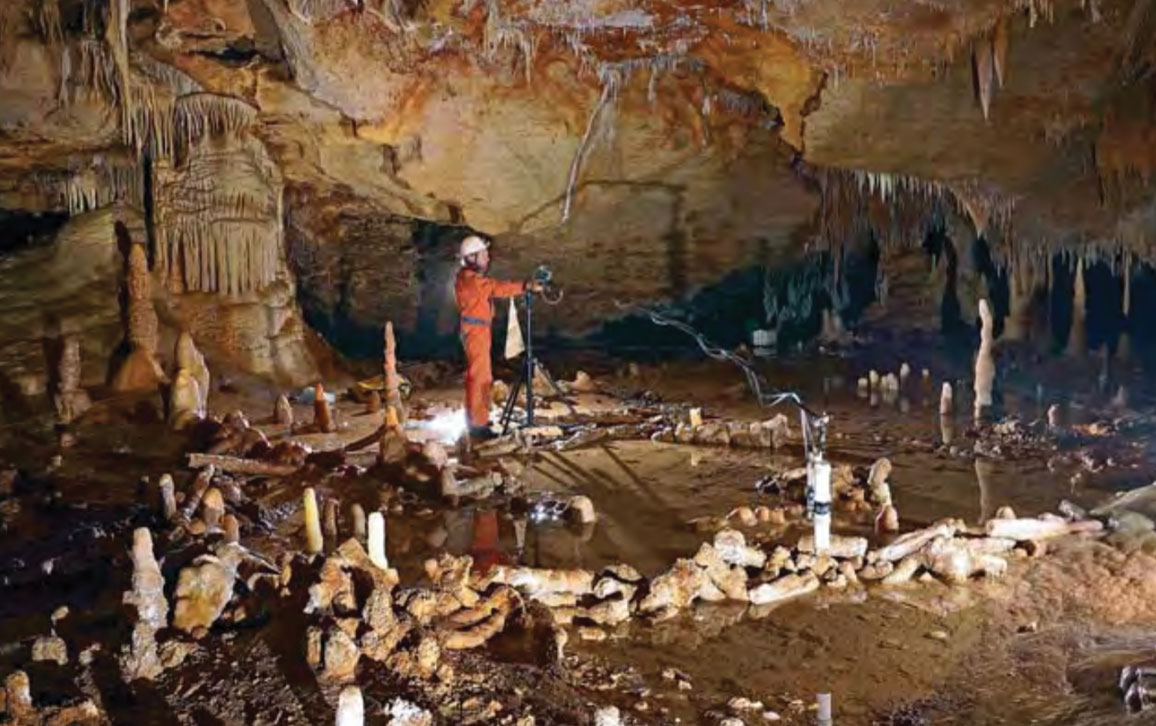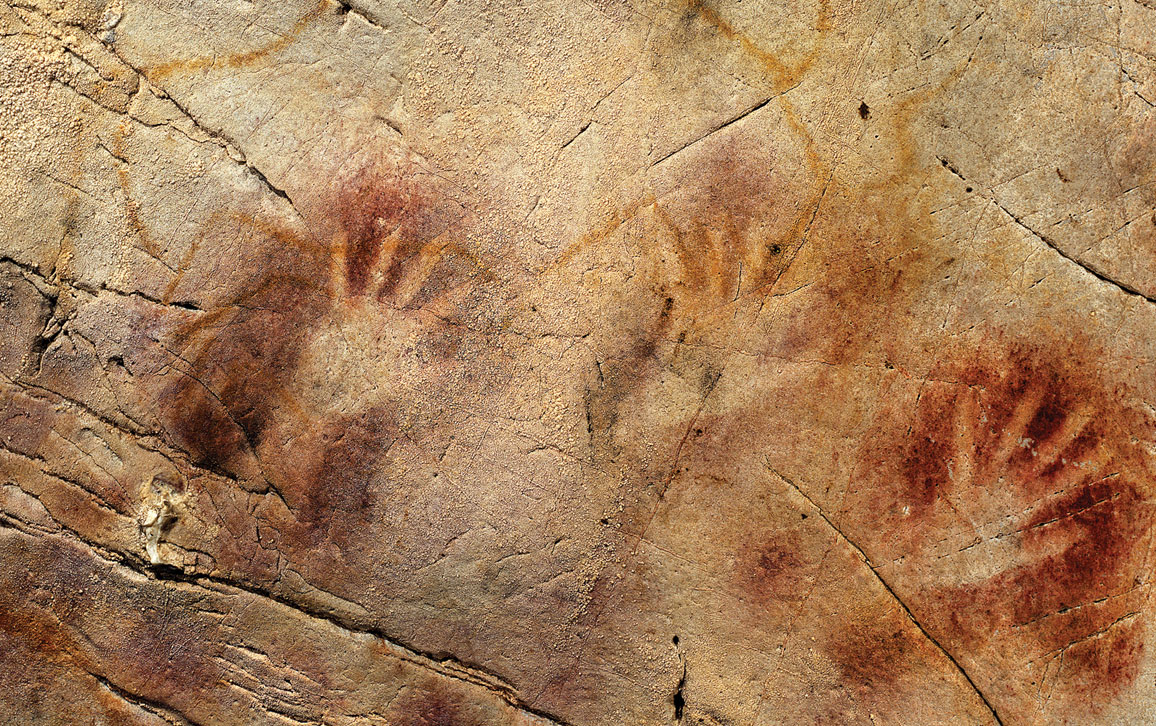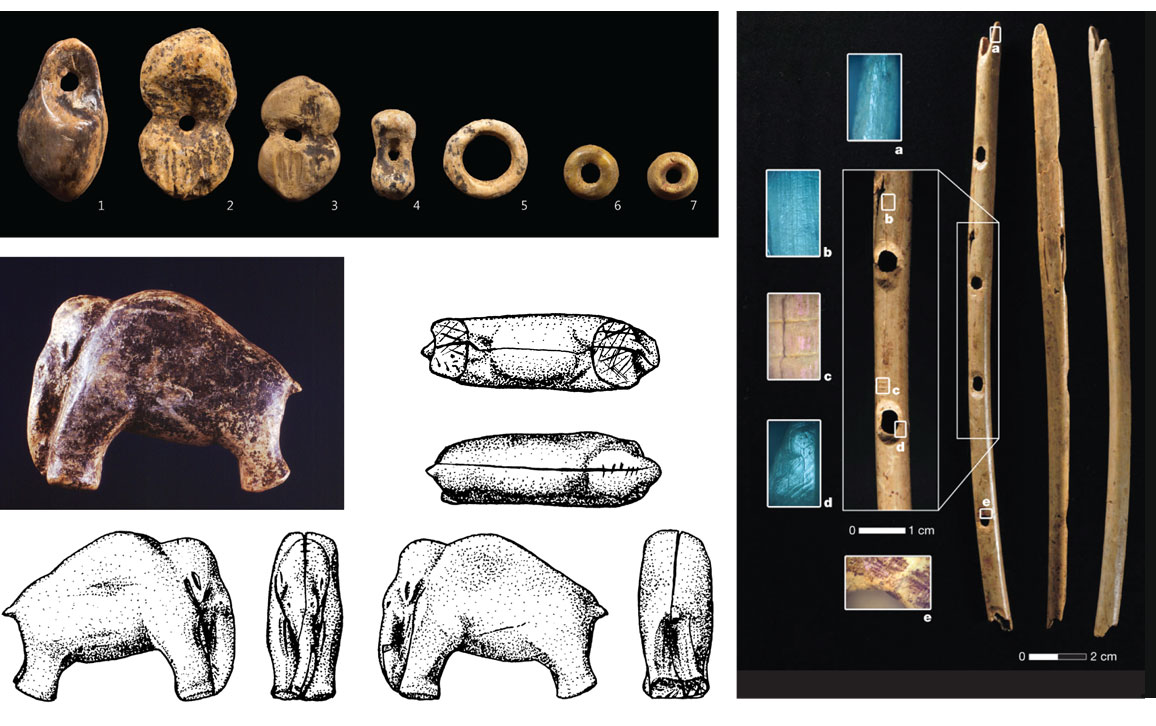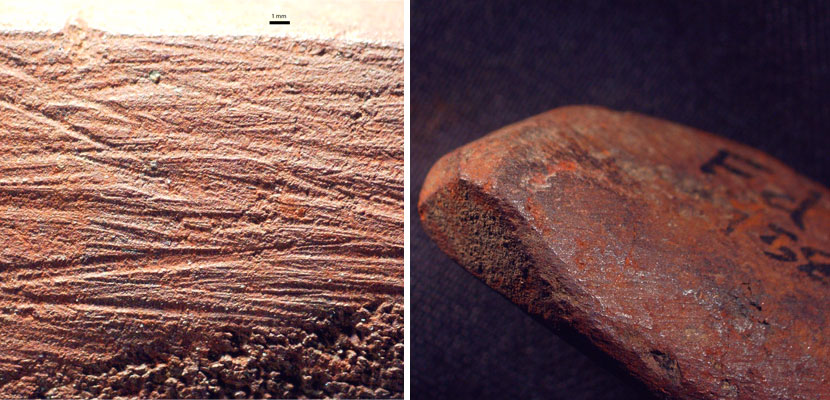Prehistoric Arts and Crafts
By Sandra J. Ackerman
At a recent meeting in the hometown of Rembrandt, archaeologists examined the images created by some really old masters of painting, sculpture, and design.
At a recent meeting in the hometown of Rembrandt, archaeologists examined the images created by some really old masters of painting, sculpture, and design.

DOI: 10.1511/2018.106.1.8
If you’ve ever wondered where human creativity comes from, try this simple experiment: Gather a random assortment of three-year-olds, anywhere in the world; distribute plenty of crayons, paper, and lightweight play blocks; and stand back.
In no time at all, the tiny research participants will begin to make things. Admittedly, what they make more than anything else will be a mess, but in their mind’s eye they are building a great big tower or drawing an awesome picture. Long before they can put together the words to describe it, these young humans are demonstrating the deep roots and the universality of the creative impulse.
Just how deep into the past those roots extend was a question that came up several times at the September meeting of the European Society for the Study of Human Evolution, in Leiden, The Netherlands. Researchers from more than 30 countries discussed new findings regarding some truly ancient examples of human creativity.
Some of the most enigmatic examples, which have been studied intensively over the past few years, are found in Bruniquel Cave in southwestern France. On the floor of a large natural chamber, hundreds of stalagmites stand or lean in what appear to be deliberate arrangements: two large circles and several smaller piles. Many of the artifacts, or speleofacts (a term coined by researcher Jacques Jaubert to acknowledge their human origin in caves), have been broken off at both the tip and the base, as if to make each one a certain length.

Jacques Jaubert
“These are exquisitely selected single stalagmites,” says Jaubert, professor of prehistory at the University of Bordeaux. The piling of smaller speleofacts into wedges at the base of larger, upright ones suggests they were used for support—a sign of intentional construction, Jaubert says. As another sign that they were deliberately handled, more than 120 of the speleofacts show traces of fire: fissuring, red discoloration or black soot, and localized increases in magnetic susceptibility, which are characteristic of cave substrate that has been exposed to fire. The evidence includes the remains of at least 18 fireplaces.
The chamber containing the speleofacts is located well inside the cave (336 meters), a placement that implies a great deal of planning and coordination. Creating the speleofact structures “would have required adequate lighting, combined with long-term access to the chamber,” Jaubert points out. In his view, the structures were a team effort, requiring both complex thinking and social adeptness—a combination of abilities that might be thought to distinguish the modern human mind at its best.
And yet, the evidence shows that these structures are much too old to have been built by humans like ourselves. Jaubert and his colleagues used uranium-series dating (which assesses the ratio of uranium-234 to its decay product, thorium-230, in a given sample) to calculate the age of calcium carbonate regrowth on the stalagmites after they had been broken off and handled. Judging by their results, the speleofacts must have been arranged about 175,000 years ago—some 130 millennia before anatomically modern Homo sapiens arrived in Europe. Throughout the continent, the only members of the human family who have left traces from this time are our now-vanished cousins the Neanderthals. For the present, Bruniquel Cave continues to hold onto the mysteries of how they created this assemblage and what its creation may have meant to them.
It’s easy to understand why there are many contenders for the title of “world’s earliest cave art”—that is, the first images created by human hands—but it is less easy to distinguish among the competing claims. “Cave art is extremely impressive evidence for human symbolic behavior,” explains Dirk Hoffmann, a research scientist at the Max Planck Institute for Evolutionary Anthropology. “Unfortunately,” he adds, “it is also one of the most difficult kinds of evidence to date accurately.” Hoffmann studies decorated caves on the northern coast of Spain. These include the UNESCO World Heritage sites of Altamira, El Castillo, and Tito Bustillo, with their red, black, and stippled animals and designs. A less famous but equally evocative sight at El Castillo is the “Panel of Hands,” a section of cave wall on which appear images of more than two dozen hands, outlined in reddish pigment. The hands are unmistakably human—but how long ago were the images made?

Dirk Hoffmann
Determining the age of cave paintings has often required sacrificing a tiny part of the picture, because the only materials that could be removed for chemical analysis were the pigments in the paintings themselves. Instead, Hoffmann and his colleagues take samples of the calcite veil or crust that has formed on top of the pigments, reasoning that it could have accumulated only after the artwork was completed. Thanks to recent refinements, uranium-series dating techniques can now be used on calcite samples smaller than a grain of rice, with no need ever to touch the art itself. It is not known how much time elapsed between the creation of the painting and the deposition of calcite over it, but as Hoffmann reported at the meeting, because the calcite crust dates to between 33,000 and 40,000 years before the present (BP), he’s confident that the “Panel of Hands” is at least that old.
Striking as the cave paintings of northern Spain may be, they’re not the only art form dating back to the Ice Age. They may not even be the oldest. Equally remarkable, and also the basis for designation as a UNESCO World Heritage Site, are the figurines, musical instruments, and jewelry excavated from caves of the Ach and Lone valleys in Germany. These objects include small carved representations of various animals, a woman, and a creature with the body of a man and the head of a lion; flutes carved from ivory and from bird bones; and innumerable beads pierced with holes for stringing. In his presentation in Leiden, Nicholas Conard, professor of early prehistory and quaternary ecology at the University of Tübingen, gave these objects an age range of 33,000 to 43,000 years.

Yvonne Mühleis © State Office for Cultural Heritage Baden-Wuerttemberg/Museum Ulm
Conard explained that he and his colleagues had identified this age range by using several dating techniques: radiocarbon, which determines how much radioactive carbon-14 (whose rate of decay is known) is missing from a sample; thermoluminescence, whereby material that is subjected to intense heat gives off flames whose properties indicate the age of the sample; and electron spin resonance, which calculates how many trapped electrons have accumulated in the crystalline structure of a sample since the time of its burial. Focusing on the older end of the range, Conard proclaims, “One can safely say the earliest and best record of figurative art and music is [here].” Colleagues who study other decorated caves might argue the point with regard to figurative art—the claim cannot be settled as long as archaeological dating techniques produce age ranges instead of definite dates—but certainly the flutes, at least, are the earliest ever found.

Nicolas Conard
Large monumental art took much longer to make its first appearance. “By far the oldest wooden sculpture in the world,” according to Thomas Terberger, of the Monuments Preservation Office in Lower Saxony in Germany, is a totem pole–like figure discovered near what is now Yekaterinburg, Russia. Almost four meters tall, with carefully carved eyes, nose, and mouth at the top and with six additional faces and numerous zigzags carved along the body, it must have been an impressive sight in its day.
The monument was exceptionally well preserved, thanks to having settled in the acidic, low-oxygen environment of a peat bog, so it was a surprise when conventional radiocarbon techniques assigned it an age of about 7,800 years. More surprising still, as Terberger reported at the meeting, were the new results he and his colleagues obtained from accelerator mass spectrometry dating, which can measure extremely low concentrations of carbon-14 in a sample: According to this method, the find is at least 10,000 years old.
The Russian totem pole thus dates back almost to the dawn of agriculture, a time that many social-studies textbooks set down as the beginning of fixed dwellings and the domestication of animals. In the popular imagination, that was around the time that society, culture, and art all emerged in the region of the Tigris and Euphrates rivers. But the new, earlier date for an elaborate carved monument far to the north—together with the finding of a perforated and decorated antler from the same peat bog and of human-form monuments in southeast Turkey from about 9,000 to 10,000 years BP—tell Terberger something different: that “complex art [was] no exclusive element of the societies of the Fertile Crescent” at that time.
The process of obtaining art supplies has had its own prehistory, which contributes to our knowledge about the conditions of life for the earliest members of our species. At the University of the Witwatersrand in South Africa, Tammy Hodgskiss analyzes how hominins have collected and used ochre for a very long time. “There is convincing evidence that ochre was deliberately collected as far back as 285,000 years ago, in Kenya,” she says. This yellowish to bright-red iron ore, found in chunks and then ground into power, has served many purposes: as a sunscreen, insect repellent, and ingredient in hide-tanning, not to mention as a pigment for decorating the body and the home.

Tammy Hodgskiss
When Hodgskiss looks at changes over time in the use of ochre, she sees a basis for inferences about the fluctuating climate in which human ancestors evolved. In places where the archaeological record shows ochre having been used more intensively, with each piece reused many times, this indicates the climate at that time was relatively cool and dry, with large areas of open grassland. In sites with evidence of less use, with fewer pieces of ochre found, the climate of the time was likely warmer and wetter, with more close-growing vegetation.
Even the humblest of art supplies has a prehistory that tells us something about our forebears. Paul Kozowyk, a research scientist at Leiden University, is probably one of the world’s few experts on the properties of ancient glues. This line of research intersects with a surprising number of fields: chemistry, of course, but also botany, pyrotechnology, mechanics, and paleoanthropology.
By comparing several different methods for the dry distillation of birch bark into a tarry, adhesive substance, Kozowyk and his colleagues have been able to recreate a process that was probably developed by Neanderthals more than 200,000 years ago—long before modern humans began to make their own form of glue from the resin of conifer trees. In this particular technological race, the Neanderthals may have gotten a head start simply because they were working with a more amenable kind of raw material. “Birch may just be more suitable for making tar in a simple way,” says Kozowyk. Sometimes, using what’s available is an art in itself.
Click "American Scientist" to access home page
American Scientist Comments and Discussion
To discuss our articles or comment on them, please share them and tag American Scientist on social media platforms. Here are links to our profiles on Twitter, Facebook, and LinkedIn.
If we re-share your post, we will moderate comments/discussion following our comments policy.